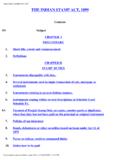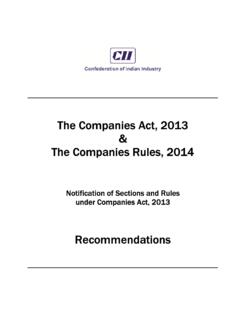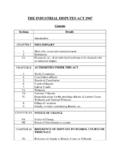Transcription of PG TRB- HISTORY - MODERN INDIAN HISTORY 1857-1947
1 PG TRB- HISTORY - MODERN INDIAN HISTORY 1857-1947 , GRADUATE TEACHER, KRISHNAGIRI. CELL : 99943 94610 Page 1 MODERN INDIAN HISTORY 1857 - 1947 Sepoy Mutiny - 1857 Sepoy Mutiny also known as Sepoy Rebellion is considered as India's first war of independence . On 10 th May 1857 AD,this famous rebellion of INDIAN HISTORY was started by INDIAN local soldiers (Sepoy) of British East India Company against the British Empire. Soon it reached to different places and became a widespread movement. Although the movement was unsuccessful and ended in 1858 AD, it was the foundation stone of the independence movement of India. Causes of the rebellion There were several reasons which finally led to the major rebellion of INDIAN soldiers against British. The main cause started 10 months prior to the actual outbreak due to General Service Enlistment Act 1856. This Act empowered British to deploy INDIAN Army in overseas assignments.
2 INDIAN Army personnel had to sign a declaration at the time of joining the force that they would work in the overseas assignment of the East India Company if necessary. Majority of the soldiers didn't have any wish to work at so far distance. There was also unhappiness among the soldiers over the issue of promotions,based on seniority. Another reason was garnering recruits from all section of the populations of different castes which initiated the grievance among the high-caste sepoys as it was against the tradition that sons following their fathers into an Army. The final and the most vital reason of the rebellion was related to the ammunition "Pattern 1853 Enfield Rifle" used by the force. The rifle used paper cartridges which were pre-greased. Soldiers had to bite the cartridge to use it. There were rumors that the cartridges were greased with animal fat like pork and beef which caused an eruption of anger to the Hindu and Muslim soldiers.
3 The rumors caused unrest in Bengal Army. On 29 th March 1857, Mangal Pandey of 34 th Bengal Native Infantry regiment attacked his British sergeant at the Barrackpore parade ground, near Calcutta. He fired Lt. Henry Baugh but missed his target and instead hit Baugh's horse. Mangal tried to commit suicide after the incident and initiated the ignition of nationalism in the hearts of millions of indians . Mangal Pandey got injured and he was captured. This incident is termed as the initial stages of the INDIAN Rebellion of 1857. On 8 th April 1857, he was sentenced to death in Barrackpore. On 24 th April 1857, INDIAN soldiers of the 3rd Bengal Light Cavalry refused to accept the cartridges in a fire drill ordered by Lieutenant Colonel George Carmichael-Smyth. PG TRB- HISTORY - MODERN INDIAN HISTORY 1857-1947 , GRADUATE TEACHER, KRISHNAGIRI. CELL : 99943 94610 Page 2 On 9 th May 1857, 85 policemen were court martialed and most of them were imprisoned for 10 years and few were jailed for 5 years.
4 The Sepoy Rebellion The major outbreak of Sepoy Rebellion started on 10 th May 1857,at the city of Meerut. The angry protesters set ablaze some of the buildings and attacked the officers and civilians quarters of British. Estimated 50 Europeans including soldiers, women and children were killed by angry sepoys. The angry mob freed their 85 imprisoned comrades from the jail with another 800 other prisoners. The next day the rebels rallied to Delhi. Many sepoy refused to obey the British orders to fight against the rebels and instead join the rebellion. On 12 th May 1857,Delhi came under the custody of the Sepoys. The Mughal Emperor Bahadur Shah II agreed to support the rebellion against British. Soon the rebellion spread to different regions like Awadh, Lucknow, Bareilly, Agra, Jhansi, Central India, and to other places. The rebellion broke out in Awadh. Nana Sahib,the adopted son of Peshwa Baji Rao along with Tantia Tope led the mutiny in Kanpur of Uttar Pradesh.
5 Rebels seized Kanpur on 5 th June 1857. Rani Lakhsmi Bai, queen of princely state of Jhansi led the rebellion against the British. British Control The Sepoy Mutiny failed to sustain due to lack of leadership and coordination. Finally, the British under Governor-General Lord Canning controlled the first independence movement of India and suppressed the movement. On 20 th September 1857,Delhi came under the control of British East India Company. The last Mughal emperor Bahadur Shah II was exiled to Rangoon of Burma. In 1862, he died in exile at the age of 87. Nana Sahib and Tantia Tope were defeated by British and Kanpur was captured by British force led by General Campbell on 6 th December 1857. British East India Company force led by Sir Hugh Rose defeated Rani Lakhsmi Bai in March 1858. Lucknow was recaptured by East India Company in March 1858. After the Sepoy Mutiny, British government took the direct control of the British occupied INDIAN territories from East India Company.
6 British Government passed the "Government of India Act 1858" and the administration of the British occupied India was transferred to the Crown of Queen Victoria. British Raj Introduction The term "British Raj" is used in INDIAN HISTORY to refer the British rule in India. The meaning of the word "Raj" in INDIAN languages is rule. In 1858, after the Sepoy Mutiny (1857 AD), British government took the direct control of the British occupied INDIAN territories from East India Company. British Government passed the "Government of India Act 1858" and the administration of the British occupied India was transferred to the Crown of Queen Victoria. PG TRB- HISTORY - MODERN INDIAN HISTORY 1857-1947 , GRADUATE TEACHER, KRISHNAGIRI. CELL : 99943 94610 Page 3 Until independence in 1947 AD, India was under the rule of British Crown. The British government ruled a large area including present day India, Pakistan, Bangladesh and Burma.
7 In 1937, Burma was separated out from British India and became a separate colony of British. India became the independent nation on 15 th August 1947, one day after Pakistan's independence . Burma got its independence from British on 4 th January 1948. Important Facts Even at the time of British rule, there were many Princely States or Native States which were ruled by INDIAN ruler under indirect control of British. In 1947, when India became independent from British rule, there were 565 princely states which merged into India. In 1885 AD, INDIAN National Congress a secular political party was founded which is regarded as one of the biggest milestones of independence movement against British raj. Gandhiji led three major independence movements to establish the independent India. 1. Non-Cooperation Movement (1920 to 1922 AD) 2. Civil Disobedience Movement (1930-1934 AD) 3. Quit India Movement (1942 AD) There were many other famous leaders who fought against British in the independent movement.
8 Finally, in 15 th August 1947, India got independence and it ended the British Raj. East India Association was one of the predecessor organizations of the INDIAN National Congress. In 1866 AD, Dadabhai Naoroji established the organization in England. It served as a forum for raising the grievances against the mistreatment of British Government. The primary goal of this association was to bring up the INDIAN point of view before the British public. East India Association successfully counter acted the propaganda of London Ethnological Society that Europeans superior to Asians and Africans. Dadabhai wanted to show the real picture of the British in India to the British public in England. Different branches of the association were organized in major INDIAN cities. INDIAN could raise their voice of grievance to Britain through this association. This association was able to attract the support of Englishmen and showed a significant influence in the British Parliament.
9 Dadabhai Naoroji believed that the British rule was not bad for India and it would be better for India's development. He believed that western education was good for India. He was also in support of the reforms and scientific inventions Arya Samaj Introduction Arya Samaj is a Hindu reform movement started by Swami Dayananda Saraswati on 10 th April 1875 in Bombay, present day Mumbai. Swami Dayanand outlined a list of 28 rules and regulations for Arya Samaj. PG TRB- HISTORY - MODERN INDIAN HISTORY 1857-1947 , GRADUATE TEACHER, KRISHNAGIRI. CELL : 99943 94610 Page 4 On 24 th June 1877, at the second Arya Samaj in Lahore, the original list of 28 rules and regulations were simplified and it was reduced to 10 Principles those are currently known around the world. Social and Religious Reform Arya Samaj doesn't believe the practices like polytheism (multiple deities), idolatry (worship of an idol), animal sacrifice, priest-craft, ancestor worship and strict rituals of Hinduism.
10 It also opposes the ideology of untouchability, caste system and child marriage. Arya Samaj is also notably known for its support to female education, widow remarriage and inter-caste marriages. Arya Samaj has also major contribution on spreading education by establishing schools and colleges throughout the country. Arya Samaj is also known for its liberal practice of welcoming other religions people to embrace Hinduism. Ten Principles of Arya Samaj 1. God, the Highest Lord (Parameshwar) is the primary cause of all true knowledge and true science. 2. God is existent, blissful, formless, merciful, eternal, omniscient, almighty, unborn, endless, unchangeable, the support of all, the master of all, omnipresent, immanent, immortal, fearless, holy and the maker of all. He alone should be worshipped. 3. Vedas are the scripture of true knowledge. It is the primary duty of all Aryas to read them, teach them, recite them, and listen to them.





